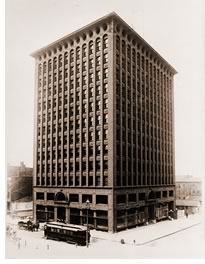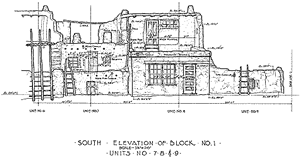

Historic American Buildings
Survey Marks
70 Years of Service
 by
James C. Massey, Assoc. AIA
by
James C. Massey, Assoc. AIA
Coordinator, HABS 70th Anniversary
The National Park Service’s Historic American Buildings Survey (or HABS, as it is generally known), America’s oldest federal historic preservation program, started life rather inauspiciously in 1933 as a Depression-era aid for underemployed architects. Luckily, its significance quickly became apparent, and the next year HABS received permanent status. It was run under a tripartite agreement among three coordinating organizations: the National Park Service, which carried out the work; the Library of Congress, which maintained the records; and the AIA, which provided professional guidance. The partnership has lasted, and HABS now offers the world’s foremost documentation of historic buildings.
HABS is an indisputable cultural treasure—a collection of 51,910 measured drawings, 167,126 large-format photographs, and 17,165 historical and architectural reports on 28,825 buildings—all archivally maintained, catalogued, and made accessible for public use by the Library of Congress’s Division of Prints and Photographs. And the HABS collection continues to grow, documenting both the great and the typical among America’s historic buildings. Arguably the most valuable records are its precise, scale, measured drawings that offer floor plans; sections; elevations; and extensive details of ornament, cornices, moldings, stairs, paneling, and hardware.
 Many
buildings recorded by HABS have since been demolished or destructively
altered, and the drawings and photographs provide a unique record from
a vanished past. Indeed, some buildings have been accurately reconstructed
after a total loss from fire, such as St. Michael’s Cathedral in
Sitka, Alaska.
Many
buildings recorded by HABS have since been demolished or destructively
altered, and the drawings and photographs provide a unique record from
a vanished past. Indeed, some buildings have been accurately reconstructed
after a total loss from fire, such as St. Michael’s Cathedral in
Sitka, Alaska.
Adopting a uniform approach
The opportunity to develop a national, uniform approach for HABS drawings
and documentation came with a proposal by a National Park Service architect,
Charles E. Peterson, FAIA. The proposal brought together the funding (New
Deal emergency funds) and the skilled workforce (architects and drafters
around the nation) needed. The National Park Service directed the work.
Following a World War II hiatus, the Park Service resumed recording in
1957, and the work continues today under the leadership of HABS Chief
Paul Dolinsky.
Along the way, HABS has fathered two companion programs: the Historic American Engineering Record, established in 1969 to record historic engineering and industrial structures, and the Historic American Landscape Survey, developed in 2002 to record landscapes and gardens.
 The
uniformity of HABS standards for documentation and its comprehensive cataloguing
have long made photographic copies from the Library of Congress easily
available. Now you can use the Internet, where the collection itself can
be viewed and downloaded—in JPEG and TIFF formats at high resolution—without
charge.
The
uniformity of HABS standards for documentation and its comprehensive cataloguing
have long made photographic copies from the Library of Congress easily
available. Now you can use the Internet, where the collection itself can
be viewed and downloaded—in JPEG and TIFF formats at high resolution—without
charge. ![]()
Copyright 2003 The American Institute of Architects.
All rights reserved. Home Page ![]()
![]()
